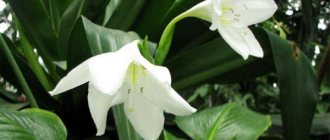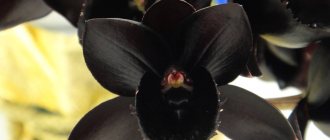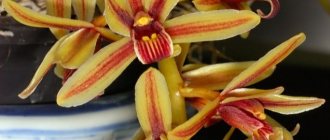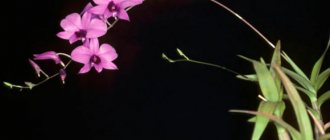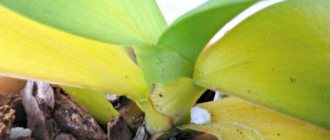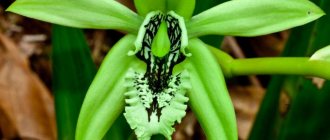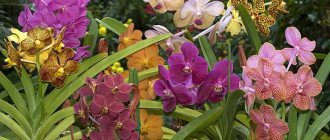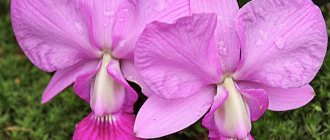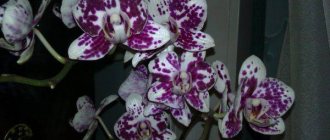Plants » Flowers
0
1560
Article rating
Kira Stoletova
Orchids are people's favorite indoor plants. But not every person has the opportunity to provide these flowers with proper care. There are less whimsical flowers, similar to orchids.
What flowers are similar to an orchid?
Sometimes it can be difficult to distinguish between different types of flowers externally. Some of them resemble an orchid. They can decorate a room or area just as well. This:
- alstroemeria;
- schisanthus;
- evening;
- iris.
They are used both as indoor crops and for decorating flower beds. To make them bloom faster, it is important to plant them in suitable soil and provide them with proper care.
Flowers similar to orchids: name, photo
Orchids are people's favorite indoor plants. But not every person has the opportunity to provide these flowers with proper care. There are less whimsical flowers, similar to orchids.
- Alstroemeria
- Schizanthus
- Vechernitsa (night violet)
- Iris
- Conclusion
What flowers are similar to an orchid?
Sometimes it can be difficult to distinguish between different types of flowers externally. Some of them resemble an orchid. They can decorate a room or area just as well. This:
- alstroemeria;
- schisanthus;
- evening;
- iris.
They are used both as indoor crops and for decorating flower beds.
To make them bloom faster, it is important to plant them in suitable soil and provide them with proper care.
Alstroemeria
Alstroemeria also has another name - “Alstroemeria”. She appears to be a cross between a lily and an orchid.
The plant is popular as a garden decoration. It attracts gardeners for several reasons:
- the bush of the desired color can be easily grown from seeds or prepared as seedlings;
- an adult flower is successfully propagated by division;
- The flower is planted in the warm period of spring, at the same time as tomato seedlings.
The optimal temperature for the crop in summer is not lower than 23°C. You should follow the watering and fertilizing regime, then flowering will occur faster and will be of better quality.
Alstroemeria loves loose nitrogenous soil, so it is fed with mineral fertilizers. The soil is loosened before planting. The flower is planted in an open, bright area without the scorching rays of the sun.
To make flowers cut from a flowerbed last longer, unopened buds and small leaves are cut off. They will open up in the vase and the bouquet will last longer.
Alstroemeria is similar to lily and orchid
Vechernitsa (night violet)
The nocturnal violet received the name “night violet” for its similarity with violets and because it smells strongly at night. This is a semi-wild crop that grows in self-gardens or is planted by humans. It is grown in flower beds - it is not a houseplant.
An adult flower has small inflorescences with 4 leaves, a large, well-defined stem, and drooping leaves.
Positive qualities of night violet:
- blooms for a long time - from May to August;
- unpretentious in care, survives drought and short cold snaps well;
- its seeds take root well in open ground and germinate well.
The crop does not require special care: it is enough to water it occasionally, if the drought persists, and weed it. She doesn't need feeding.
The noctule plant has one drawback: it is a two-year crop; it blooms only in the second year.
Eveningweed is grown only in flower beds
Iris
Iris combines a large number of varieties of different shapes and colors. The flowers are similar to an orchid, only tightly curled and with fringe at the edges. Irises are often chosen for growing in the garden, but they can also be grown indoors. One of these subspecies is Neomarica.
To achieve spectacular flowering in March, suitable conditions are created for it:
- In summer, keep it on the balcony, in a bright place, and be sure to ventilate it.
- In winter, set the temperature at 8°C-10°C, place the flower in a dark place for 2 weeks, do not water or fertilize.
Irises look like an orchid, but are tightly curled and have fringe at the edges.
Neomarica is then transplanted into new soil. She prefers loose and acidic soil, saturated with charcoal.
The variety reproduces by peduncles, which often degenerate into babies.
The long peduncle descends to the soil and takes root on its own. For this reason, Neomarica was popularly nicknamed the “walking iris.” Low-growing bearded irises are grown in the same way.
Wonders of nature || PHOTO LAND (flowers, flowers photos, flowers flowers) DRACULA ORCHID: HOW TO GROW A MONKEY ORCHID. MONKEY ORCHID. REPRODUCTION OF MONKEY ORCHIDSunusual and rare species of orchids. Beautiful orchid flowers. Amazing plants. ORCHIDS: PRESERVING A FLOWER
Schizanthus
Schizanthus is known as a garden plant, but low-growing varieties are also quite suitable for indoor keeping.
Initially, schisanthus, unlike a genuine orchid, is not an indoor or even greenhouse plant, but a garden plant. From potted gardens, these flowers gradually adapted to being kept indoors. In conditions that do not depend on the vagaries of nature, they bloom much more abundantly and for a long time. Schizanthus is propagated by seeds, planting seedlings in August-November. The sowing period can be extended until April if desired. In this case, the beginning of flowering is postponed to autumn.
The author of the video channel about growing flowers and garden crops is Nadezhda Poplavskaya.
Home conditions:
| Season | Place | Care |
| Summer | A ventilated balcony or loggia in bright sunlight, but without direct exposure to scorching rays | Care as usual: abundant watering and spraying with weekly feeding with complex fertilizers |
| Winter | In the apartment on the windowsill | Provide a period of rest |
Unfortunately, schisanthus is an annual plant and does not bloom again. At the end of the flowering phase, the plant is thrown away.
Hemanthus
What is the name of the red flower that looks like a calla lily?
In the wild, hemanthus, elephant ear or deer tongue, grows in the tropical rainforests of South Africa. About 40 species of this deciduous or evergreen shrub are known. The shape of hemanthus leaves resembles orchid leaves.
Each plant has three pairs of symmetrically arranged leaves. During the period of active growth, hemanthus forms only one pair of leaves. Their surface may be smooth, sticky or slightly hairy.
During flowering, spherical inflorescences bloom on the plant, resembling a large pompom, consisting of many small flowers of various colors.
The disadvantage of the plant is its strong unpleasant odor, which repels insects. When caring for a flower at home, you should remember that its fruits and bulbs contain poisonous juice, which can cause burns.
Botanical classification of orchids
The American scientist Dressler divided the many-thousand-strong plant family of orchids into several subfamilies:
- Orchids (orchids). Includes more than 200 genera and even more subspecies. These are perennials that grow on the ground, with an erect stem. The most famous of them are Phalaenopsis, Dactylorhiza and Anacamptis with large spike-shaped inflorescences.
- Epidendral. Includes more than 20 thousand subspecies of perennials, which in the wild are found in the subtropics, tropics and temperate latitudes. The most striking representatives of this subfamily are Dactylostalix, listed in the Red Book, as well as Cattleya, noticeable for its large bright flowers.
Cattleya hybrida
- Vanilla. These are herbaceous plants or branched vines that grow in Asian countries, South and Central America. A large number of flowers bloom on one inflorescence. The Vanilla variety has a pleasant vanilla aroma that attracts pollinating insects.
- Cypripediaceae. Includes more than 130 varieties of orchids - epiphytic perennial rock and terrestrial herbaceous plants. Representatives of this subfamily prefer subtropical, tropical and temperate climates. Many Russians especially loved the Lady's slipper, which is distinguished by its unpretentiousness and high decorative qualities.
- Apostasiaceae. Small herbaceous perennial plants that grow in Indochina, New Guinea, Japan, Australia. This subfamily is also divided into 2 families - Neuwiedia and Apostasia.
- Neuwiedia
- Apostasia
Most orchids are epiphytes, meaning they need additional support in the form of another flower. Most of them are perennial herbs. You can rarely find shrubby orchid species and their names, as well as woody vines from this family.
Few people know that there are lithophyte orchids that grow on rocky slopes and stones; their varieties and species with names can only be found in reference books for gardeners. The middle subgroup of orchids consists of terrestrial crops. They, like everyone else, have tubers or rhizomes that absorb microelements, moisture from the soil, produce photosynthesis along with foliage, and also help the flower maintain an upright position.
Ambulance: Orchid diseases and their treatment
Based on the type of flowers, orchids are also divided into 2 types: a simple raceme on a high peduncle with several flowers, which grows along the main stem, and a spike-shaped inflorescence with single flowers. Tropical orchids attract pollinating insects with their pleasant, rich aroma. Martyrs imitate the smell of female bees, which attracts males. Slipper orchids produce shoe-shaped inflorescences with an invisible trap for flies, bees, wasps, bumblebees, and beetles. In good natural conditions, in home flower beds and greenhouses, healthy varietal orchids live up to 70-100 years.
Exotic and rare flowers
What is the name of an indoor flower with long narrow leaves?
Not all bush flowers for bouquets, the colorful photos and names of which we reviewed above, can surprise a fastidious lady or an artsy gentleman. Rare flower arrangements from the following options are more suitable for them:
- Gloriosa is an exotic beauty for unusual and bright solutions.
- Amaranth is an amazing plant with hanging inflorescences.
- Brassica is an unusual flower for wedding arrangements and holiday decorations.
- Celosia - similar in texture to carnations, often complements other plants in voluminous and lush compositions.
- The spherical craspedia will certainly become the central flower in the autumn and winter composition.
- Tillandsia xerographica is a rare flower that looks like a jellyfish. Its curling grayish long leaves look great in vintage bouquets.
- Echeveria - goes well with dahlias, often used to create winter bouquets with eucalyptus and dried flowers.
- Astilbe is a romantic ornamental plant with elongated, fluffy and lush inflorescences.
Rare garden and wildflowers will undoubtedly enchant and leave a lot of pleasant emotions and impressions. With proper care, they last in a vase for a long time.
Phalaenopsis Gigantea
Phalaenopsis Giant is distinguished by the impressive size of its leaf blades. This variety of orchid is very malleable, and breeders often use it for crossing and breeding new hybrids.
Giant Phalaenopsis (Phalaenopsis Gigantea).
The stem of this species is not so easy to see, since it is entirely hidden under the bases of the leaves. The leaves are huge, leathery, drooping. The peduncle is also drooping, rarely branched, length - about 40 cm, number of flowers - 10 - 30. Usually an adult plant has several peduncles, which together can boast of the presence of about 100 round-shaped flowers. The aroma is sweetish citrus.
Giant Phalaenopsis (Phalaenopsis Gigantea).
The color is cream, yellow and greenish-yellow, with raised reddish-brown spots or streaks. Taking into account the size of the plant, we can say that this is not the best Phalaenopsis option for home conditions, but it is perfect for greenhouses with sufficient space.
Features of reproduction
What flower is called with the letter sh. flowers starting with the letter w
Amazing, spectacular orchids do not reproduce easily, so there are not so many of them in the gardens of lovers of exotic rarities.
Dividing the bush
It is easier to propagate these plants by dividing the bush. The procedure is usually carried out in the spring, the shoes are divided at the end of summer. I choose mature, developed and absolutely healthy plants.
The orchid is carefully removed from the loose soil by hand, and the rhizome is carefully divided into two or more parts. Each of them should have at least two, and preferably three, vegetative buds. Then each part is planted in its place, proceeding in the same way as when planting a plant.
Then each part is planted in its place, proceeding in the same way as when planting a plant.
Seeds
Propagation of orchids by seeds in artificial conditions is a complex, labor-intensive, multi-year process.
In the first years, the development of the seedling takes place in close connection with special fungi. After some time, a struggle for survival begins between the symbiotes, many seedlings die. The surviving plants develop for another 4-5 years until the seedling can be planted in the ground. And only after another 4-6 years does the first flowering occur.
The work is carried out by specialists in breeding centers under sterile conditions.
Seed propagation of orchids at home is unlikely.
Orchid-like flowers
Not all orchids are alike. And then there are the experts... Some in publications consider Phalaenopsis, Vanda, Dracula and Cattleya to be similar. Why are they similar? They are real orchids! Well known.
Advice! Be very careful with information on the Internet. Write to earn money
There is no responsibility. Read 3-4 sources and make sure. Don’t be lazy to compare and use your brains.
Some flowers have similarities with orchids. And it's a good resemblance. After all, even phalaenopsis at dusk were mistaken for butterflies. So they got the appropriate name. Read the description of the appearance carefully. So as not to be confused.
Schizanthus. From the nightshade family. And his relatives are tomatoes.
Night violet. Matiola. The cruciferous family.
Bearded iris. Irises are experiencing a new wave of popularity. Like in Ancient Greece.
Read more about orchid-like flowers in this article.
Night violets
In nature, night violets, similar to small orchids, are found in Central Europe, the Mediterranean, and Asia. Their beauty has always been admired, this is confirmed by lines from the works of the ancient Roman writer Pliny. Night violets belong to the cruciferous family. White, violet or lilac flowers, each with 4 petals, form a lush cluster.
Some varieties have double flowers. Violets are actively used to decorate parks and summer cottages. In general, they are unpretentious, but lack of water can kill them.
Types of orchids, their names and photos
In this section you will learn what types of indoor flowers there are, their descriptions, pictures of plants of the orchid family.
With bulbs
The bulb, or more precisely the pseudobulb (tuber, tuberidium) is a storage of nutrients. The thickening at the bottom of the stem, the “outer bulb.”
Plants with pseudobulbs belong to the sympodial type of development.
What types of orchids with pseudobulbs are there:
- lelia;
- oncidium;
- miltonia;
- odontoglossum;
- Cattleya;
- dendrobium;
- carrot orchid.
You can read more about the Lelia orchid here.
Unpretentious
Indoor phalaenopsis hybrids grow and bloom well in living rooms and are well suited for beginning gardeners. Most other species and varieties require a more individual approach.
Dendrobium, Cattleya, oncidium, Vanda are also quite easy to grow, observing the conditions: during the day it is 7 degrees warmer than at night, do not overwater in winter.
Cattleya (photo of flowers in pots).
Sympodial
Sympodial species grow in bushes, with several shoots from one rhizome:
- Cattleya;
- Cambria;
- oncidium;
- Cymbidium.
The main root is located horizontally inside the soil; new shoots with pseudobulbs easily grow from it.
Orchids are divided into monopodial and sympodial types.
Smelling
The aroma of orchids varies from completely absent to a strong, pleasant fragrance. Vanilla type flower is also used in the food industry.
The most odorous types:
- vanilla;
- lelia;
- miltonia;
- celogina;
- Cattleya;
- dendrobiums;
- phalaenopsis (many varieties);
- cymbidiums;
- Cambria;
- zygopetalum;
- miltoniopsis;
- oncidium.
Rare
The orchid family is so vast and unusual; there is a considerable list of rare species. Here are the most beautiful and rarest of them:
Royal blue phalaenopsis. Botanists from the Japanese university Chiba University created the Royal Blue variety based on the phalaenopsis Aphrodite, placing the blue gene in it. So far this miracle is not available to ordinary amateur flower growers. The basis of the unique new species is also rare - the phalaenopsis Aphrodite orchid is very difficult to propagate by seeds, so it is not grown on an industrial scale;
Royal blue phalaenopsis.
- white heron orchid, habenaria or leopard radiata;
- Flying Duck Orchid (Caleana Major);
- Odontoglossum.
Indoor
Varieties of indoor orchids include many varieties, since with skillful care even the most exotic plant will feel good, but with an inexperienced and inattentive gardener, even a stable hybrid phalaenopsis can quickly die.
Types of indoor orchids:
- phalaenopsis and its varieties;
- dendrobium;
- Wanda;
- brassia;
- miltonia;
- lelia;
- zygopetalum;
- celogina;
- cymbidium;
- oncidium;
- odontoglossum and many other species.
Find out more about what indoor orchids are and a description of these plants in our article below.
New
Based on natural species, every year new orchid hybrids are created for indoor cultivation with an extended flowering period and a reduced dormant period, of all kinds of shapes and colors.
New varieties are grouped according to the place of creation; for example, Taiwanese hybrids are distinguished.
By mixing the characteristics of different species, we obtained novelty phalaenopsis, on which new buds grow from the apical bud right during flowering. You can see a picture of the novelty variety below.
A variety of Phalaenopsis novelty flower.
Other types
You can find other types of orchids in garden centers. For example, this is Angrekum Leonis, which has a peculiar but pleasant smell, as well as sickle-shaped leaves. On the peduncle, no more than three very large flowers with waxy white petals are formed (less often they are ivory-colored).
Flower growers also love zygopetalum - this is a rather rare type of orchid, but extremely beautiful because it is distinguished by its graceful petal shape and unusual color. Beginners are often afraid to purchase zygopetalums, thinking that such an unusual species requires some special, labor-intensive care. But in fact, this is just a common misconception. Caring for zygopetalum differs little from other types of orchids that form pseudobulbs. At the same time, it looks very impressive thanks to petals with various colors and patterns of spots and inclusions. Zygopetalum blooms mainly during the winter months. On one peduncle, from 10 to 20 buds are formed, which then open into medium-sized flowers, emitting a delicate sweetish aroma.
Catasetum is another original variety of orchid. A distinctive feature is the ability to simultaneously form flowers that differ in size and color. And all because both male and female, and even bisexual flowers bloom on one plant. At the same time, they look very decorative.
Cattleya can hardly be called exotic; it is a very common species, which includes varieties with both large and small flowers. In garden centers, Cattleya is represented mainly by hybrids. They can be white, pink, lilac, beige in color.
A very beautiful type of orchid is the dendrobium. It is distinguished by decorative cylindrical leaves and spectacular flowers, the diameter of which can reach 6-8 cm. They are collected several at a time into inflorescences formed on long peduncles. Among the varieties of dendrobium, two-color varieties are especially popular. Dendrobium blooms twice a year, in winter and summer. Depending on the specific variety, the color of the flowers can be pink, beige, or purple.
Cambria is a decorative flowering hybrid. It was obtained by crossing several species of orchids. Its main advantage is the varied colors of the flowers.
It is quite difficult to recognize it among other similar species if you do not pay attention to the flowers themselves - this plant does not look like a butterfly, its flowers are star-shaped. In addition, Cambria is characterized by a shoot type of growth.
Its leaves are narrow and elongated, and have a dark green color. Up to 10 quite large flowers are formed on one peduncle. The disadvantage of this type of orchid is that it is a rather capricious plant, requiring constant maintenance of temperature and light conditions, as well as a certain level of humidity.
Another capricious plant is celogina. It is quite rarely grown at home, since celogina is demanding. But it blooms with very beautiful and fragrant snow-white flowers. It blooms profusely (at least 10 buds are formed on one peduncle), and its flowering period is long - up to three months, so all efforts to grow will not be in vain.
Macodes looks very nice. This plant is distinguished by decorative foliage, which is quite rare for an orchid. And in this case, it has not only a spectacular color with streaks of golden, silver or copper shades, but also a surface that is velvety to the touch. Its leaves themselves come in different shades - from light green to cherry and even amber-black. True, makodes are just as capricious as the species listed above, even if their beauty compensates for all the troubles associated with them.
What species are royal orchids? In fact, such a plant is unlikely to be found in botanical classifiers. Large varieties of phalaenopsis are called royal. However, some varieties of the Vanda orchid also have this name. So it’s hardly possible to talk about any specific species here. In addition, any orchids themselves are so beautiful that they can safely be called royal.
floricultureorchidsindoor plants
Alstroemeria
Alstroemeria is an extremely light-loving plant, but does not tolerate direct sunlight. In the summer heat, she will need shading on a south window. This plant requires at least 14 hours of daylight to bloom profusely.
Alstroemeria, depending on the variety, can have different bush heights, shapes and colors of inflorescences.
Growing indoor Alstroemeria involves annual spring replanting. The plant requires a large, deep container, since the root system develops very quickly.
Composition of the soil mixture for indoor alstroemeria:
- drainage layer of pebbles and expanded clay - up to ¼ of the pot;
- leaf litter - 2 parts;
- humus – 1 part;
- peat – 1 part;
- coniferous tree bark – 1 part;
- perlite/vermiculite – 1 part.
When purchasing ready-made soil, you should choose a soil mixture for azaleas.
Habitats in nature
In tropical climates and temperate latitudes, orchids even grow very well. It all depends on the climate:
- On the trees. They don't need land. And they are not pests to trees. Even many herbivores are not afraid of them;
- On the rocks. Find cracks and crevices with moisture;
- In the ground. And they can’t do it without soil.
Read more about the growth of orchids in nature here.
In forests
These beauties are found in shaded areas. Even high in the mountains (over 2000 meters) they live next to large trees.
They attach themselves to them with their strong roots. They take moisture and nutrients from the bark of trees.
Frequent and heavy tropical rains, sun and a long warm period are their optimal conditions.
How to properly replant an orchid
The most favorable time for replanting a plant is the beginning of the period after the end of flowering: late May or June
It is important to remember that the plant does not tolerate transplantation well, so this point should be taken into account when caring. An orchid in a pot (photo of which is in the article) is replanted only if necessary
And this need arises if:
- the pot has become too small for the grown flower;
- the death of individual parts of the plant occurred;
- the time has come to replace the substrate.
Replanting is done very carefully and carefully so as not to damage the roots. Sometimes it is better to cut the pot. You should carefully examine the root system, clearing it of soil. Use sterile scissors to remove damaged and dried roots. Rinse the root system in clean water, place soil in the pot, lower the orchid and carefully cover the roots with the substrate. After transplantation, the plant should be kept in a shaded place for 2-3 days and then returned to its usual conditions.
Features of caring for snow-white flowers
- All white orchids need a lot of light, but it should be diffused; direct sunlight will leave burns on the snow-white petals. Almost all of them need additional lighting in winter. Due to lack of light, an orchid may simply not bloom.
- The favorable air temperature for orchids is 22-27 degrees with a mandatory difference between day and night temperatures of 4-5 degrees, and for the Draconian Dendrobium a daily difference of 7-9 degrees is recommended. During the dormant period, orchids require a lower temperature of 16-18 degrees, for Dendrobium delicate 10-12 degrees, and for Habenaria White Heron 8 degrees.
- Humidity is also important for these white orchids. For phalaenopsis it should be about 60-70 percent, but Dendrobium Drakensis requires an air humidity of 80-85 percent from spring to autumn.
- Orchids should be watered with filtered or settled water using the immersion method. Often in summer and rarely during dormant periods. It is imperative to wait until the water has completely drained. Water should not get into the growing point to avoid rotting. All orchids tolerate drought better than overwatering.
In Habenaria Medusa, after flowering, the leaves turn brown, this is a signal that the plant has begun to pump nutrients into the new tuberia. Reduce watering when the leaves begin to wilt and allow the soil to dry completely. Tuberia should be stored in an almost dry substrate at a temperature of 16 degrees until new shoots appear. To prevent wrinkling of tuberia, light spraying is recommended.
In Habenaria White Heron, it is recommended to remove the tubers in the fall, dry them and store them in a container with peat.
If transparent smooth pots are recommended for all orchids, then Habeniria White Heron loves coolness and its roots should be completely covered with soil, so for it the pot should be wide, made of a material that does not conduct heat - stone or clay.
White orchids symbolize love, purity and femininity. They add peace and harmony to a person. It is believed that caring for a white orchid helps you meet your soulmate faster.
Algorithm for making a bouquet
When composing a bouquet, experienced florists recommend following a certain algorithm of actions in order to make fewer mistakes in the process. For example, if you first prepare the flowers, and only then begin to determine the shape, then you may end up with extra buds that you will simply have to throw away.
- We decide what the future composition will look like.
- Choose a suitable shape that matches the size of the bouquet.
- We select a good color scheme that harmonizes with the packaging.
- We decide on the number of flowers of each color and type.
- We prepare flowers using a knife or pruning shears.
It is worth noting that it is best to cut flowers at an angle of 45°, and then immediately place them in water. If you are making flowers for a store, then the cut must be regularly updated so that the flower can absorb water. With such manipulations, the compositions will last much longer.
Iridodictium
Under natural conditions, the plant can be found in the mountainous zone. This species belongs to the irises, as evidenced by the inherent shape of the flowers and leaves.
Most often you can find yellow, purple and blue iridodictiums. The plant is sometimes called snowdrop and blooms in February. Iridodictium is a bulbous iris that produces just one large flower. To grow a plant, it must be provided with proper lighting. Feeding is acceptable during the formation of the green part of the flower.
Before planting, you should take care of the soil and select slightly alkaline or neutral areas. Iridodictium does not like excess moisture, so you should avoid groundwater and water only in dry times.
Roses
Roses are the most common type of flower for bouquets on the planet. They will be an ideal option for almost any holiday, and also if you do not know the preferences of the person to whom you want to give flowers. Roses are used by almost all florists in the world, but few people know about the significance of this type of flower for bouquets:
- red roses represent passion and love;
- white - purity, tenderness and mystery;
- yellow – joy and boundless happiness;
- cream – constancy, harmony, perfection.
If you don’t know what color of roses to give as a gift, then it is strongly recommended to focus on the meaning of the flowers, since some people always look for hidden meaning in gifts. It will be quite awkward if you give red roses to someone for whom you do not have loving feelings.
It is also impossible not to say that roses combine harmoniously with almost any type of flower. Among the most successful compositions: lavender, lilies, callas, lilacs, gypsophila, daffodils, lilies of the valley. Any material made in a calm tone is suitable for packaging.
Exotic flowers for bouquets
If you are bored with classic compositions of roses and lilies, then you can create some exotic composition using the appropriate flowers. The most optimal and affordable option for this purpose would be orchids native to Central America. Flowers represent love and beauty and are the perfect decoration for almost any occasion. It is highly recommended to use them in combination with roses in wedding bouquets. An indisputable advantage is that orchids retain their original appearance for quite a long time, which makes them especially attractive to florists.
We hope that the names and photos of flowers for bouquets presented in our article helped you figure out how to create an unusual and beautiful bouquet. Professional florists recommend not to be shy about experimenting, since this is how you most often achieve the perfect composition. Also, do not forget that each flower has its own meaning. If you want to present a bouquet to a young lady in order to win her heart, then this should definitely be taken into account.
Caring for a home orchid during flowering
For long and abundant flowering, an indoor flower must create certain conditions:
- An intense humid climate is important for the plant. Watering must be done with warm water 35 degrees.
- For a flowering plant, the temperature at night should be 5 degrees higher.
- You cannot replant an indoor orchid when it has already begun to bloom.
- In order for the plant to maintain its unique coloring, it is necessary to increase feeding during flowering.
Choosing a unique type takes quite a long time. A variety of leaf models, names, and colors will help everyone choose a flower to their liking. It is not for nothing that this plant is a symbol of aristocracy and wisdom. Orchids represent peace of mind, love, beauty and homeliness.
Hybrids
There are many hybrids among orchids. These are varieties that were bred through selective breeding. They do not grow in the natural environment, but they are better adapted to life in indoor conditions than others. That is, this culture does not react so quickly to changes in external factors, making it more suitable for novice gardeners.
The Dragon
This is one of the most popular hybrids today. Here is a brief description of it:
- The height of the peduncle can reach 60 cm.
- The stem is thin, dark in color, completely hidden by leaves.
- The leaves are hard and bright green. There can be up to six of them.
- The flowers have a typical orchid shape. Delicate, pink. There are a large number of dark dots on the petals.
- The lip is yellow-white. There are also dark spots on it.
This plant has extraordinary beauty and is also very easy to care for. That is why many gardeners today prefer to grow this particular variety of orchids at home.
With white spots (Panther)
This is another classic orchid hybrid that was obtained through selection. It is not found in the natural environment.
Externally, the flower is similar to the Dragon orchid, but there are differences:
- five petals white;
- there are a large number of pink spots of different shapes and sizes on the petals;
- the lip is completely pink, separated from the main flower by about two centimeters.
The panther is an incredibly beautiful flower, which at the same time requires standard care. The height of the peduncle can reach 60 cm.
Royal terry
This orchid is a little different from all the others. Here are its features:
- The size of the plant reaches one meter.
- The flower is regular in shape, completely pink. There are no inclusions on it. The buds are large and emit a pleasant aroma.
- The flowers are light and beautiful, pink in color.
Bearded iris
This flower looks like an orchid, although it belongs to the iris genus. The lower petals are decorated with a strip of fibers of a contrasting color, similar to a wedge-shaped beard, like the French. Some irises also have a beard on their upper petals.
The bearded iris flower, like all rhizomatous plants, prefers a lot of light, moderate watering and fertile soil with good drainage. Does not like rainy weather, dampness and high humidity.
Answers to flower growers' questions
Question No. 1. My irises bloom for no more than two weeks, despite the potential stated by breeders of 1-1.5 months. How to prolong flowering?
Each iris bud opens only for two days, after which it has to be removed, but after the withered flower the next one blooms immediately. The flowering period is shortened by hot weather. At temperatures above +28 °C, growth stops and buds drop. Excessive feeding, which activates life processes, has a negative effect on the duration of flowering. During the flowering period, fertilizer application should be reduced or stopped altogether.
To preserve the aesthetic appearance of the inflorescences, faded iris flowers are removed in a timely manner.
Question No. 2. What to do to protect home alstroemeria from bacterial and fungal infections?
To prevent infectious diseases, dried leaves and wilted buds are promptly removed. During the growing season, old drying stems are shortened to 10 cm, and at the end of the flowering phase, the shoots are cut off at a height of 7 cm above the ground.
Conditions of detention
Favorable conditions are the key to successful growth and development of each orchid variety, Cymbidium is no exception.
Lighting
For hybrids, lighting is the number one need throughout the year. It grows in a subtropical climate, so in winter the orchid should receive as much light as possible. However, every year new hybrid varieties appear that are less demanding of lighting.
Humidity and watering
The nature of Cymbmdium requires high humidity, especially during the period of growth and development. The main rule is that the more humid the air, the better . Watering should be regular and abundant, on average once every 5 days.
Temperature
Cymbidiums are fans of coolness and sudden temperature changes.
Therefore, active flowering can only be achieved if there is a difference in night and day temperatures of at least 8 degrees. The best option is 10.
Recently, new hybrids have appeared that are immune to temperature changes, but so far there are few of them.
Soil for planting and growing
The ideal soil is a mixture of pine bark, dried fern roots and moss. The roots of this orchid variety begin to rot from the earthen soil. This is because the root system must receive a sufficient amount of air, which is not possible with the soil mixture.
The air saves from waterlogging and unwanted diseases, and also supplies the root system with nutrients.
Pests
There are 3 methods to combat this insect:
- mechanical - you need to wear gloves and crush the pests with your fingers;
- chemical - it is necessary to treat the plant with insecticides, for example, “Aktara” or “Inta-Vir” in accordance with the instructions;
- folk - spray the flower with a solution of laundry soap.
Shchitovka
To get rid of scale insects, you need to wipe the plant with a toothbrush or cloth soaked in a soap or alcohol solution and treat it with Aktara.
Spider mite
It is necessary to wash the leaves with a solution of tobacco and soap, rinse them with warm water and treat the sorrel with Akarin, Fitoverm or Actellik.
Delicate and sophisticated lilies
Before collecting a bouquet of lilies, it is better to study the names and photos of its varieties, because these unusual flowers do not always combine with each other. At all times, the lily has been considered a symbol of purity and purity, which is why it is most often chosen to decorate a wedding celebration. The following varieties of lilies are distinguished:
- Cream and white - Dewdrop.
- Pink and lilac – Sonata.
- Orange – Wave.
- Yellow – Autumn song.
- Red – Scarlet Sails.
Bright orange, yellow and burgundy flowers go well with delicate light bells, daisies, and irises. You don’t need to think long about what flowers are added to chic bouquets with lilies. These include branches of mimosa, jasmine, and small bush carnations. Each florist compiles his own list of names of beautiful flowers for bouquets with photos and a detailed description of creating a unique composition.
The main similarities of plants
Since all orchids are classified in the same family, they have some similarities. These include:
- Type of inflorescence. All plants of the family have flowers collected in the form of a brush or spike.
- The flowers have one petal that stands out from the others - the lip.
- They are pollinated exclusively by insects.
- Numerous seeds collected in a box or berries.
- Seeds germinate only with the formation of mycorrhiza.
Interesting! These characteristics unite all types of orchids with very rare exceptions. For example, the famous lady's slipper is also an orchid, but it has single flowers, not collected in inflorescences.
In general, it is not difficult to distinguish orchids from other plants.
Phalaenopsis Pleasant or Amabilis (Amabilis)
The Phalaenopsis amabilis orchid, which is known as the Phalaenopsis Pleasant or in Filipino, the "Mariposa" orchid, is a magnificent Philippine orchid species that is very important in producing modern standard Phalaenopsis orchid hybrids. Its flower shape is similar to large butterflies or butterflies flying in the air.
Phalaenopsis Pleasant or Amabilis (Phalaenopsis Amabilis).
large inflorescences, curved branches, on which 15-20 flowers usually grow, the diameter of which reaches 11 cm. The flower lip can have various shades of snow-white, pink or yellowish color. The aroma of flowers is pleasant and subtle. Flowering lasts up to four months, from October to March, when peak flowering occurs.
The most fragrant orchids with a spicy scent: (read more)
Phalaenopsis Amabilis has four to eight fleshy, oblong leaves that are dark green in color. Inflorescences are formed on flexible, slightly curved peduncles of decent length (up to one and a half meters).
Orchid Phalaenopsis amabilis.
If the peduncle is cut just below the first flower, a replacement peduncle will form. This orchid is the progenitor of numerous hybrid varieties, as it is considered the most suitable species for crossing.
Diseases and pests of orchids
Most often, due to inattention to the plant or improper care for it, the following troubles can arise:
- The appearance of flabby leaves indicates non-compliance with the temperature regime. Additional funds will not be required if the situation is corrected in time.
- Cracks in the middle of the sheet - a sharp change in temperature after watering.
- Black spots, holes and growths are sunburn.
- The leaves dry out and rot - a soft-bodied mite has appeared, which is located in the middle of the rosette. To combat it, acaricidal drugs are needed.
- A cobweb appeared on the underside of the leaf - a spider mite had infested. If you do not pay attention to this, the leaves and flowers will turn yellow and rot. To destroy the pest, you need to use the biological product “Fitoverm”.
- The flower suddenly stops flowering and growing - nematodes have appeared on the back of the leaves, sucking the juice out of them. To destroy them, use nematicides.
Having conquered all ailments, the plant will again delight you with its beauty, as shown in the photo of orchid flowers in pots above.
Aquatic killer whale
This plant is related to irises, but is more of a false calamus plant. The yellow flowers of iris are very similar to iris. The plant is also called yellow iris or marsh. In nature, this plant is found in Ukraine, Russia, Crimea, Siberia and the Caucasus. The ideal area for growth is the coastal part of rivers, swamps or wet meadows.
The flower belongs to herbaceous perennials, the roots of which develop many adventitious branches that go deep. Leaves and stems begin to grow from the very roots. The leaf blade of the aquatic iris is approximately 2 cm wide, it is rich green in color and slightly pointed towards the top.
The flowering is quite large, the yellow buds have slightly curved petals. At the end of flowering, a box is formed with many seeds having a flattened shape. Yellow iris blooms from early June to mid-summer.
Alstroemeria
Alstroemeria is an extremely light-loving plant, but does not tolerate direct sunlight. In the summer heat, she will need shading on a south window. This plant requires at least 14 hours of daylight to bloom profusely.
Alstroemeria, depending on the variety, can have different bush heights, shapes and colors of inflorescences.
Growing indoor Alstroemeria involves annual spring replanting. The plant requires a large, deep container, since the root system develops very quickly.
Composition of the soil mixture for indoor alstroemeria:
- drainage layer of pebbles and expanded clay - up to ¼ of the pot;
- leaf litter - 2 parts;
- humus – 1 part;
- peat – 1 part;
- coniferous tree bark – 1 part;
- perlite/vermiculite – 1 part.
When purchasing ready-made soil, you should choose a soil mixture for azaleas.
Important! Alstroemeria juice is poisonous, so the plant should be kept out of the reach of children and pets. When working with flowers, it is better to use gloves to eliminate the risk of skin irritation.
What is special about Tricyrtis when growing it?
As mentioned above, caring for a garden orchid is a difficult task, requiring a lot of effort and patience, because this flower is very capricious when grown. First of all, you need to choose a suitable place on the site to plant Tricyrtis
What is important when choosing soil? The main thing is that it is fertile and loose. If you choose clay soil, you can’t even expect any flowers; garden orchids will not grow on such soil
In addition, this flower also does not like direct sunlight, so you should avoid growing Tricyrtis in such places.
To feed orchids, it is best to use already rotted compost or humus.
As for how often a garden orchid is watered, you need to remember that the best watering in this case is moderate. If the water stagnates, it will be very destructive for the roots, they will rot, and this cannot be corrected in any way. Compost (humus) serves as fertilizer for garden orchids. Tricyrtis cannot be fertilized with fresh manure. If these tips are followed correctly, you can expect Tricyrtis to bloom in July-August.
There is also an option such as growing flowers in containers, which is indispensable for those who live in countries and regions with harsh climatic conditions. To plant a garden orchid in a container, you need to choose the period of early spring, from late March to early April. The rhizomes are buried about 10 cm into the ground, covered with earth, compacted a little and watered. A flower grown in a container must be kept in a warm, well-lit place. In summer, it is allowed to keep the container with Tricyrtis in the fresh air, and after the garden orchid has finished flowering, the flower must be placed in the basement.
Monopodial growth type
Plants are characterized by vertical growth, during which the size of the new leaf will always be larger. Over time, the newly formed and previous leaves will become the same size. Examples of orchids of this type are phalaenopsis, vanda and others.
- Phalaenopsis - this plant in the wild reaches a height of two meters, indoors its size is much smaller. Standard plants - up to one meter, dwarf plants - up to thirty centimeters. The flower has many varieties and hybrids. The plant has powerful flower stalks, numbering forty corollas. The flowers look like moths.
- Vanda - this plant belongs to the monopodial type of orchids. In its natural environment it grows in the plains and mountain forests of southern countries, including China in the east. Cut flowers have the unique property of not withering for a long time, due to which the plant is considered a popular cut crop in southern Asia. A variety of this flower is Vanda blue. Place of growth: India and Thailand, Burma and China. It is distinguished by a strong, erect stem without leaves at the base. The height of the plant ranges from sixty to eighty centimeters. The leaves are arranged in two rows, opposite. They have a dark green color and an unusual shape in the form of two unequal blades. The leaves are hard and located only at the top. Their length reaches eighteen centimeters, and their width reaches three. The inflorescences are thirty to sixty centimeters long and are lateral. They contain up to twenty large blue flowers, their diameter is nine centimeters. Flowering time is autumn (from August) and winter (to December).
Wanda
The homeland of this flower is South Asia. The inflorescences, whose length ranges from 30 to 60 cm, consist of two dozen luxurious buds with a diameter of 9 cm.
Petal color:
- pink,
- purple,
- white,
- blue.
Vanda has the rare quality of not fading for a very long time when cut, so it is actively used by Chinese, Burmese, and Indian florists in various flower arrangements and bouquets.
Attention. If Vanda is cared for correctly, flowering begins 1.5-2 years after the plant was planted.
We offer you to read a complete review of Vanda flowers.
